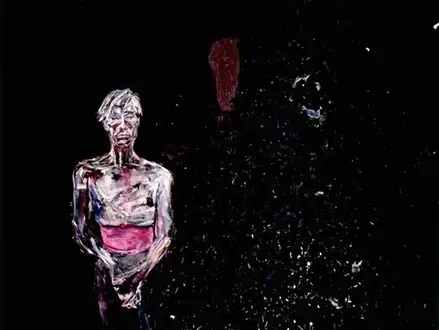Title of Artwork: “Portrait of Andy Warhol”

Artwork by Julian Schnabel
Year Created 1982
Summary of Portrait of Andy Warhol
A haunting image of Andy Warhol was depicted by Julian Schnabel in Portrait of Andy Warhol (1982). Neo-expressionism was the term used to describe Warhol’s friendships with younger artists in the 1980s. Jean-Michel Basquiat, David Salle, and Julian Schnabel were among the artists who participated.
All About Portrait of Andy Warhol
The friendship between Warhol and Schnabel resulted in a creative exchange of ideas and materials. Julian Schnabel was created by Warhol in 1982, the same year Schnabel painted Portrait of Andy Warhol (1982). The majority of Schnabel’s portraits were painted directly from life, with no prior sketches.
Schnabel had Warhol sit for him several times before he finished the painting. A fragile and thin Warhol is depicted by Schnabel, who portrays him as a ghost-like figure who appears to dissipate in front of the viewer. In this painting, Warhol is shown without a shirt but donning a pink-painted waistcoat as a form of support.
Since the attempted murder of Warhol by activist Valerie Solanas, this supporting device has been in place. In the aftermath of this, Warhol was deeply traumatised, and it had a profound effect on his work.
By painting on black velvet, Schnabel continued his experimentation with unconventional materials. To make the colours in the velvet stand out even more, the velvet has a shiny quality.
Schnabel’s art relies heavily on the use of unconventional materials, such as broken plates, velvet, and fur, to elicit visual and psychological responses from the viewer. Paintings that incorporate commonplace objects in their compositions elicit memories and associations for viewers.
Scholars have pointed out how Schnabel’s portrait’s colour palette, style, and atmosphere are reminiscent of other artists. El Greco’s depiction of the saints, for example, evokes a similar mood as Warhol’s vulnerable presence and wiry figure.
Schnabel’s works frequently feature Catholic imagery and themes, so it’s possible that he was trying to evoke religious connotations with this piece. The painting exudes an air of mysticism or spirituality, depending on how you look at it. the colours and dark mood can be linked to Francis Bacon’s portraits, such as Study for a Portrait I (After the life mask of William Blake) (1955) andMan in Blue VII (1959). (1954).
Because Warhol is on the left side of the canvas, the painting’s other elements are free to interact. Schnabel uses white dots and small blue and yellow strokes to cover the right side of the canvas.
This type of biomorphic shape will appear frequently in Schnabel’s later paintings, such as in this painting. The specks of colour may be glittering dust from the light of the film projector, which is depicted in the dark background.
Information Citations
En.wikipedia.org, https://en.wikipedia.org/.

























